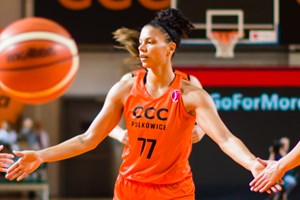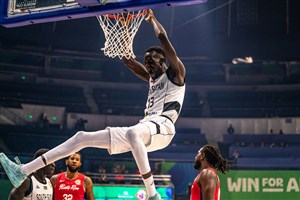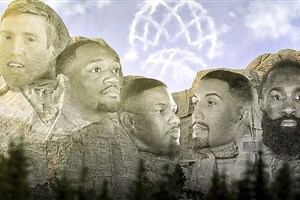
Are Tom and Mika still needed?
MELBOURNE (Paulo Kennedy’s View from Downunder) – The New Zealand squad for the upcoming FIBA Basketball World Cup qualifiers has been announced, and as is usually the case with the Tall Blacks it has a few surprises and plenty of youth.
Nenad Vucinic was the master of pulling young talent out of apparent obscurity and placing them into the black and white singlet, where they would usually do their nation proud.
Paul Henare served a long apprenticeship under Vucinic as both a player and coach, so it’s probably no surprise he has continued the trend that has unearthed players like Alex Pledger, Tom Abercrombie, Corey Webster, Tai Webster, Shea Ili and Isaac Fotu before their time.
What was surprising to me was the question posed by a highly-respected follower of international basketball, who monitors every continent closely and has long admired the pluck of the Tall Blacks.
This question was posed shortly after New Zealand’s masterful displays in both China and Korea in the February qualifying window, when the Webster brothers, Ili, Jordan Ngatai, Fotu, Rob Loe and Alex Pledger had all taken their turn to shine.
It was a new-look Tall Blacks, with athleticism, versatility, disruptive defence and an element of funk much less associated with New Zealand basketball in the past than high-IQ play and disciplined execution.
Thus the question came – are the Tall Blacks now better suited to play without Tom Abercrombie and Mika Vukona?
It was asked with respect for what that pair have provided the national team for so long, but with an understanding that the new generation are doing things in a different way.
It took me aback and set me thinking. Of course, for this upcoming window those two worldly veterans are essential.
Steven Adams unavailable as Tall Blacks name squad https://t.co/zz5vi1dkjp pic.twitter.com/5aHlekxGs7
— nzherald (@nzherald) June 13, 2018
With Steve Adams again absent, Pledger unavailable, Tai Webster a non-starter, Ili with NBA commitments in the lead-up and Corey Webster’s status reliant on whether his Chinese team releases him, the TBs need all the stars they can get.
This is especially the case given the July match-up with China will be at the cavernous Spark Arena in Auckland, where a large turnout would be a great boost for national team basketball in New Zealand.
But the question posed was more big picture. If the Tall Blacks can have Adams setting picks and rolling to the basket for dump-offs and o-boards, with the Webster brothers and Ili coming off those man-sized screens and looking to score or create.
Then Fotu, Loe, Ngatai and Co are spreading the floor, with Reuben Te Rangi ready to provide the creative flair he is offering his country on a more regular basis, it’s a model to move forward with.
At the other end that group provides an energy to play a different style of defence from the mix-it-up, smoke-and-mirrors style Abercrombie and Vukona have been a part of for so long. That pair now struggle physically to apply defensive heat for sustained periods.
While there is no doubt they can still play their role, is it time to let the next generation grow into Henare’s system so by the time they hit China 2019 – and a win over China in a fortnight would go close to booking them a ticket – they are a unit with great experience together?
That line of thought certainly has merit, but does it stack up when set alongside the bigger picture of next year’s World Cup and the challenge of qualifying directly for Tokyo 2020?
Playing in Asia, the Tall Blacks are a strong and athletic team, and this gives their young group an advantage over most outfits they’ll face in the qualifiers.
But once they get to China next August the playing field changes, teams from Europe, Africa and the Americas come into play. What does that mean? On different nights the Kiwis will have different advantages and different disadvantages.
If Adams and Pledger are both on board the Tall Blacks will have a strong centre combination, with the ability to go smaller with Fotu or Loe.
But the reality is those players don’t have a marked size advantage over many European frontcourts like they do in Asia, and teams from Africa and the Americas will likely still be more athletic than this New Zealand team, even if it is a significant step up in that regard from its forebears.
So how do Abercrombie and Vukona fit into that equation? That pair have smarts, they know international basketball, they know what works against different opponents.
They can guide their younger teammates and act as extra coaches on the court, on the training floor and in the locker room. They can help players deal with the situations that pop up off the floor in major tournaments. When things get tricky down the stretch on the floor, they’ve been there before.
So yes, it’s a valid point to make that New Zealand are heading in a different direction to what we have become accustomed to, and that neither Abercrombie nor Vukona is likely to be still around when the next exciting generation really hits their straps.
But are the Tall Blacks better off without their two long-time servants? Quite possibly in the Asian game, but there are bigger fish to fry than that.
If Adams finally commits next year, alongside Fotu, Pledger, Loe, Finn Delany, Te Rangi, Ili, the Websters and whoever the next young gun to emerge is, they can do some serious damage at the World Cup.
But to navigate their way past opponents from around the globe they are going to need experience, and for mine that means Abercrombie and Vukona remain a key part of the plan.
Paulo Kennedy
FIBA
FIBA's columnists write on a wide range of topics relating to basketball that are of interest to them. The opinions they express are their own and in no way reflect those of FIBA.
FIBA takes no responsibility and gives no guarantees, warranties or representations, implied or otherwise, for the content or accuracy of the content and opinion expressed in the above article.

















